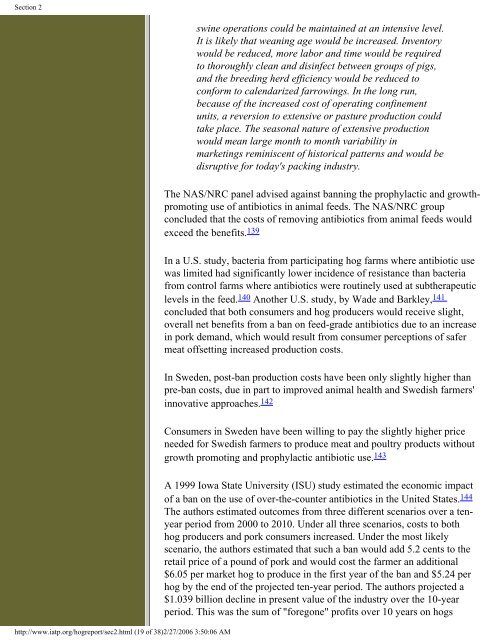IATP Hog Report - Institute for Agriculture and Trade Policy
IATP Hog Report - Institute for Agriculture and Trade Policy
IATP Hog Report - Institute for Agriculture and Trade Policy
Create successful ePaper yourself
Turn your PDF publications into a flip-book with our unique Google optimized e-Paper software.
Section 2<br />
swine operations could be maintained at an intensive level.<br />
It is likely that weaning age would be increased. Inventory<br />
would be reduced, more labor <strong>and</strong> time would be required<br />
to thoroughly clean <strong>and</strong> disinfect between groups of pigs,<br />
<strong>and</strong> the breeding herd efficiency would be reduced to<br />
con<strong>for</strong>m to calendarized farrowings. In the long run,<br />
because of the increased cost of operating confinement<br />
units, a reversion to extensive or pasture production could<br />
take place. The seasonal nature of extensive production<br />
would mean large month to month variability in<br />
marketings reminiscent of historical patterns <strong>and</strong> would be<br />
disruptive <strong>for</strong> today's packing industry.<br />
http://www.iatp.org/hogreport/sec2.html (19 of 38)2/27/2006 3:50:06 AM<br />
The NAS/NRC panel advised against banning the prophylactic <strong>and</strong> growthpromoting<br />
use of antibiotics in animal feeds. The NAS/NRC group<br />
concluded that the costs of removing antibiotics from animal feeds would<br />
exceed the benefits. 139<br />
In a U.S. study, bacteria from participating hog farms where antibiotic use<br />
was limited had significantly lower incidence of resistance than bacteria<br />
from control farms where antibiotics were routinely used at subtherapeutic<br />
levels in the feed. 140 Another U.S. study, by Wade <strong>and</strong> Barkley, 141<br />
concluded that both consumers <strong>and</strong> hog producers would receive slight,<br />
overall net benefits from a ban on feed-grade antibiotics due to an increase<br />
in pork dem<strong>and</strong>, which would result from consumer perceptions of safer<br />
meat offsetting increased production costs.<br />
In Sweden, post-ban production costs have been only slightly higher than<br />
pre-ban costs, due in part to improved animal health <strong>and</strong> Swedish farmers'<br />
innovative approaches. 142<br />
Consumers in Sweden have been willing to pay the slightly higher price<br />
needed <strong>for</strong> Swedish farmers to produce meat <strong>and</strong> poultry products without<br />
growth promoting <strong>and</strong> prophylactic antibiotic use. 143<br />
A 1999 Iowa State University (ISU) study estimated the economic impact<br />
of a ban on the use of over-the-counter antibiotics in the United States. 144<br />
The authors estimated outcomes from three different scenarios over a tenyear<br />
period from 2000 to 2010. Under all three scenarios, costs to both<br />
hog producers <strong>and</strong> pork consumers increased. Under the most likely<br />
scenario, the authors estimated that such a ban would add 5.2 cents to the<br />
retail price of a pound of pork <strong>and</strong> would cost the farmer an additional<br />
$6.05 per market hog to produce in the first year of the ban <strong>and</strong> $5.24 per<br />
hog by the end of the projected ten-year period. The authors projected a<br />
$1.039 billion decline in present value of the industry over the 10-year<br />
period. This was the sum of "<strong>for</strong>egone" profits over 10 years on hogs

















